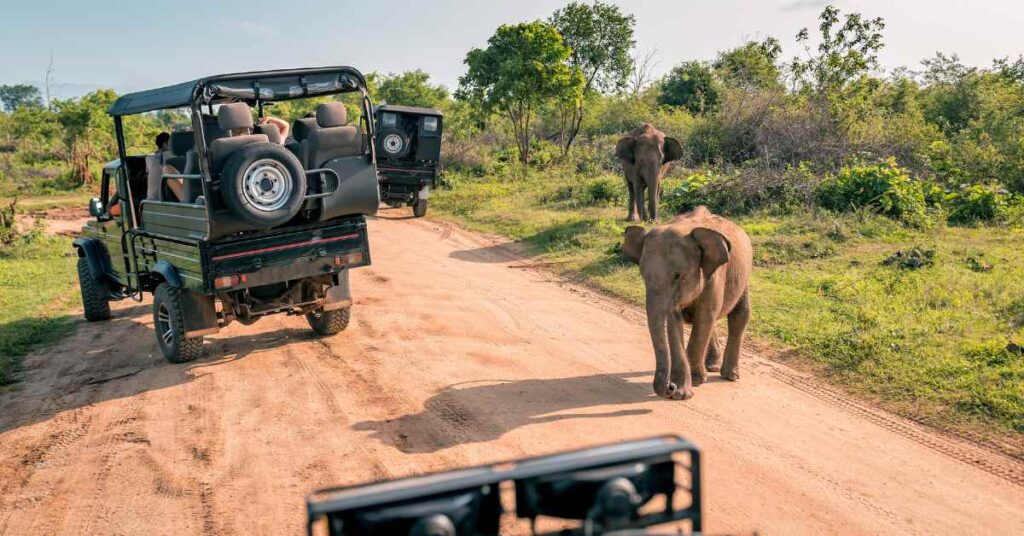Sri Lanka, an island in the Indian Ocean, is famous for its stunning landscapes and rich wildlife. Among the island’s natural wonders, Udawalawe National Park stands out as a prime destination for nature and wildlife enthusiasts. In this guide, we will look at Udawalawe National Park, its beautiful landscapes, fascinating wildlife, and the best ways to enjoy your visit.
Discovering Udawalawe National Park
Udawalawe National Park, located in the southern part of Sri Lanka, covers 30,821 acres. The park is known for its biodiversity and varied ecosystems, making it a top wildlife destination.
Location of Udawalawe National Park
Udawalawe National Park lies in the southeastern part of Sri Lanka, close to Embilipitiya. Its accessibility makes it a popular stop for travelers heading from Colombo to the southern coast.

Where to Stay Near Udawalawe National Park
Choosing the right accommodation enhances your visit to Udawalawe. Here are various options catering to different budgets:
- Luxury Lodges: For a premium experience, high-end lodges offer spacious rooms, fine dining, and guided tours. Notable options include Kalu’s Hideaway, Grand Udawalawe Safari Resort, and Kottawatta Village.
- Mid-Range Hotels: Comfortable stays at affordable prices are available at Centauria Wild, Athgira River Camping, and Ekho Safari Tissa.
- Budget-Friendly Choices: Guesthouses and homestays such as Elephant Trail Guesthouse, Udawalawe Green Park Hotel, and Dewmini Roti Shop & Guest House offer affordable, clean accommodations.
- Camping: For an adventurous stay, you can camp within the park. Be sure to book in advance and follow park regulations for a memorable experience.
A Brief History of Udawalawe National Park
Established in 1972, Udawalawe National Park was created to protect Sri Lanka’s elephants and other wildlife. Its location near the Udawalawe Reservoir provides water for both wildlife and local communities, helping mitigate human-wildlife conflicts.

Udawalawe Elephant Transit Home
The Udawalawe Elephant Transit Home, established in 1995, cares for orphaned elephant calves and prepares them for a life in the wild. Visitors can observe feeding times and learn about the park’s conservation efforts.
Wildlife at Udawalawe National Park
Udawalawe is best known for its elephants, but the park is home to many other species, including leopards, sloth bears, water buffalo, and numerous bird species.
Birdwatching in Udawalawe
The park’s diverse habitats are ideal for birdwatching, with both endemic and migratory species. Early mornings and late afternoons are the best times for sightings. Notable species include the Sri Lanka junglefowl, red-faced malkoha, and Malabar pied hornbill.
Nocturnal Wildlife of Udawalawe
Udawalawe is also home to many nocturnal creatures like the jungle cat, rusty-spotted cat, fishing cat, and slender loris. Consider taking a night safari for a chance to see these elusive animals.

Safaris at Udawalawe
A safari is the best way to experience Udawalawe’s wildlife. Here’s what you can expect from your safari:
- Private Safari: Personalized tours for families or small groups. While more expensive, private safaris offer flexibility.
- Group Safari: A more affordable option that allows you to share the experience with others.
Types of Safari Vehicles
Udawalawe safaris typically use sturdy 4×4 jeeps:
- Open-Top Jeeps: Perfect for photography and unobstructed views.
- Closed-Top Jeeps: Provide shelter and air conditioning for those who prefer more comfort.
- Self-Drive Safaris: For experienced off-road drivers with the necessary permits.
- Eco-Friendly Safaris: Choose a tour operator that practices sustainable tourism.
Additional Activities at Udawalawe
Udawalawe offers more than safaris:
- Nature Walks: Guided walks let you explore the park’s flora and fauna on foot.
- Photography: With its scenic landscapes and wildlife, Udawalawe is ideal for photographers.
- Cultural Experiences: Visit nearby villages, markets, and interact with locals to learn about Sri Lankan culture.
Safari Tips for Udawalawe
To get the most out of your safari:
- Book Early: Safaris can fill up quickly, especially in peak seasons.
- Best Times: Go early in the morning or late in the afternoon when animals are most active.
- Dress Comfortably: Wear lightweight clothing, comfortable shoes, and bring sunscreen, sunglasses, and a hat.
- Stay Hydrated: Carry a reusable water bottle.
- Respect Wildlife: Keep a safe distance and avoid disturbing animals.
- Leave No Trace: Follow eco-friendly practices during your visit.

When to Visit Udawalawe
The dry season (December to March) is ideal for wildlife viewing as animals gather around the few remaining waterholes. However, Udawalawe is open year-round with seasonal highlights at different times.
What to Pack for Udawalawe
Essential items for your trip:
- Comfortable clothing and hiking shoes
- Sunscreen, sunglasses, and a hat
- Binoculars and camera
- Insect repellent
- Water bottle
Exploring Udawalawe’s Countryside
The area surrounding Udawalawe is rich in cultural experiences. Visit nearby villages, explore local markets, and take cycling tours for a deeper connection with the region.
Nearby Hotels to Udawalawe National Park
Several hotels near Udawalawe National Park offer comfortable accommodations with easy access to the park. Many provide safari booking services for their guests.
Read : Unveiling the Magnificence of Lipton’s Seat: A Journey Through Haputale’s Spectacular Viewpoint

